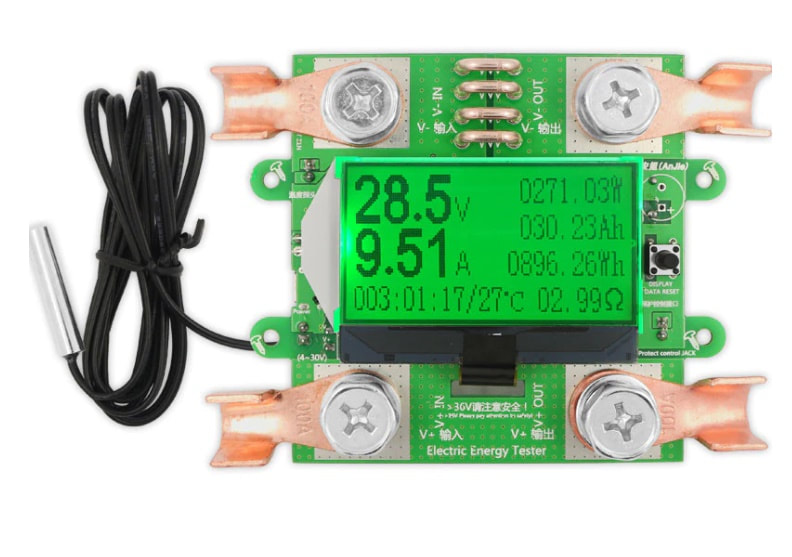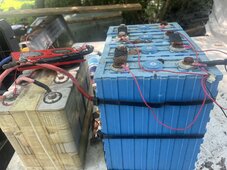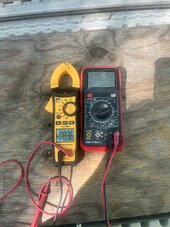You are using an out of date browser. It may not display this or other websites correctly.
You should upgrade or use an alternative browser.
You should upgrade or use an alternative browser.
Batteries
- Thread starter btemplet
- Start date
sunshine_eggo
Happy Breffast!
They are very likely CALB. I have similar cells in their 40Ah versions, both the gray and blue styles.
The left battery is an absolute travesty. The right battery has clearly been left outdoors. Rusty bolts? Really?
To be frank, given the condition of the terminals and sloppy construction, they should not be used without extensive cell capacity and IR testing.
The left battery is an absolute travesty. The right battery has clearly been left outdoors. Rusty bolts? Really?
To be frank, given the condition of the terminals and sloppy construction, they should not be used without extensive cell capacity and IR testing.
sunshine_eggo
Happy Breffast!
Got them for nothing plan on taking them down, cleaning them and putting them back together. Can I parallel them? They both took a charge to 14.1 V.
Probably what they're worth.
Given that you repeated the question, I'll repeat the answer:
To be frank, given the condition of the terminals and sloppy construction, they should not be used without extensive cell capacity and IR testing.
robbob2112
Doing more research, mosty harmless
Looks like they have been left outside for animals to pee on...
OR more likely a very damp place for years.
I am with Sunshine - take them apart, clean them up, discard ALL the connecting hardware and bolts... capacity test each cell individually - this doesn't just mean will it take a charge, it means charge them and then discharge them in a way you can measure the capacity... and using a 1035+ meter to get the internal resistance would be a good idea......
SEE if the cells match each others pretty close - then reassemble with new good hardware and no-ox-id on the contacts (not the bolt threads) and charge as a unit.
See if they are both the same or similar AH, if so you should be able to parallel them. I only see one BMS in your picture, you need one for each.
And just for fun I would do all this away from flamable objects in case something goes wrong.
OR more likely a very damp place for years.
I am with Sunshine - take them apart, clean them up, discard ALL the connecting hardware and bolts... capacity test each cell individually - this doesn't just mean will it take a charge, it means charge them and then discharge them in a way you can measure the capacity... and using a 1035+ meter to get the internal resistance would be a good idea......
SEE if the cells match each others pretty close - then reassemble with new good hardware and no-ox-id on the contacts (not the bolt threads) and charge as a unit.
See if they are both the same or similar AH, if so you should be able to parallel them. I only see one BMS in your picture, you need one for each.
And just for fun I would do all this away from flamable objects in case something goes wrong.
robbob2112
Doing more research, mosty harmless
This is the meter I have - I wanted the various lead types - you should be able to get by with just the test probe leads - just pick the option you need.
The Eggo is a fine guy and provides a lot of help to folks. And he bleeds blue - i.e. is is the king pappa smurf and knows everything about all things Victron.
The Eggo is a fine guy and provides a lot of help to folks. And he bleeds blue - i.e. is is the king pappa smurf and knows everything about all things Victron.
robbob2112
Doing more research, mosty harmless
Looks to be a cheap copy of a Daly BMS so I wouldn't recommend cleaning that just bin it and fit two.
I am with you on this one - I don't think I would trust it simply because of the condition it is in from being left wherever it is....
It might work, but it might overcharge a cell to the point of venting and fire with all the corrosion I see on the leads..... I suppose you could open it up and see if the board was conformal coated (looks like a thin rubber coating over the whole board) when mfg. If it was you can probably clean it up and try it. If it wasn't then it needs to be trashed.
Not by the looks of it I'm afraid I can't see any battery test function on either of these pictures so doing a simple DC voltage measurement means nothing a battery tester tests voltage under load (has a resistor to induce a load across terminals) a simple multimeter cannot do this.So pretty much in a decent old meter would work. I have these two I assume they would be OK they would be OK.
sunshine_eggo
Happy Breffast!
YR-1035+ will allow you to measure the internal resistance of each cell.
Will recommends a couple of inexpensive cell testers:

Whatever was done here was so far from best practices, YOU need to start over completely and fully evaluate everything before even considering putting them into service for any reason.
Will recommends a couple of inexpensive cell testers:

Battery Capacity Testers
I make a commission for purchases made with the links below
www.mobile-solarpower.com
Whatever was done here was so far from best practices, YOU need to start over completely and fully evaluate everything before even considering putting them into service for any reason.
robbob2112
Doing more research, mosty harmless
So pretty much in a decent old meter would work. I have these two I assume they would be OK they would be OK.
They will be useful for general troubleshooting. Neither will let you read internal resistace of a battery. Neither one is fine grained enough to read the impeadance of a connection - i.e. with the 1035+ you bolt a lug to something and measure across the lug and the other thing it will let you how many milliohms there are....
The YR1035+ works by sending a 1khz square wave through the device being tested and it DC isolated. So you can get an ohms reading of the internals of a battery.
A regular ohms meter just puts a known DC voltage across the item being tested and uses a voltage divider to figure out what the value is. It isn't DC isolated and if you put it across a battery the most likely result will be a chance to post in the up-in-smoke section and buy a new meter.
You can get the 1035+ cheap (half the cost of amazon) on ali express if you are willing to wait while for it to ship.
I am gonna ask the question - is the salvage for learning or do you have an intended purpose in mind?
Last edited:
robbob2112
Doing more research, mosty harmless
YR-1035+ will allow you to measure the internal resistance of each cell.
Will recommends a couple of inexpensive cell testers:

Battery Capacity Testers
I make a commission for purchases made with the links belowwww.mobile-solarpower.com
Whatever was done here was so far from best practices, YOU need to start over completely and fully evaluate everything before even considering putting them into service for any reason.
@Will Prowse or @Supervstech - the link to the battery testor on your page is out of date

Battery Capacity Testers
I make a commission for purchases made with the links below
www.mobile-solarpower.com
Oh yeah that's my site, I'll update it. Darn, that one was awesome
Similar threads
- Replies
- 2
- Views
- 197
- Replies
- 8
- Views
- 621
- Replies
- 2
- Views
- 175
- Replies
- 1
- Views
- 181
- Replies
- 2
- Views
- 267




